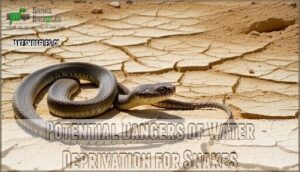This site is supported by our readers. We may earn a commission, at no cost to you, if you purchase through links.

Most snakes survive 7-14 days without drinking, though this varies dramatically by species.
Desert dwellers like rattlesnakes can push 2-3 weeks, while water-loving species struggle after just a few days.
Your pet snake shouldn’t go beyond a week without fresh water – it’s like asking someone to run a marathon without Gatorade.
Temperature and humidity play huge roles too.
Hot, dry conditions cut survival time in half.
The snake’s size and health also matter.
Some species have clever tricks for water conservation that’ll surprise you.
Table Of Contents
- Key Takeaways
- How Long Can Snakes Go Without Water?
- Longevity of Snakes Without Water
- Factors Affecting Snake Water Survival
- Desert-Adapted Snakes and Water Dependencies
- Water-Adapted Snakes’ Resilience Sans Water
- Potential Dangers of Water Deprivation for Snakes
- Providing Water for Snakes: Best Practices
- Frequently Asked Questions (FAQs)
- How often do snakes need water?
- How long can a snake go without eating or water?
- Can water snakes live without water?
- How long can snakes go underwater?
- Can snakes drink other liquids besides water?
- How do snakes find water sources in the wild?
- Do snakes urinate, and how does this affect hydration?
- Can snakes get overhydrated from drinking too much water?
- Can snakes absorb water through their skin?
- Do baby snakes need water more frequently?
- Conclusion
Key Takeaways
- You’ll find most snakes survive 7-14 days without water, but desert species like rattlesnakes can last up to 200 days while water-loving species struggle after just a few days.
- Your snake’s survival time depends heavily on species, temperature, and humidity – hot, dry conditions cut their survival time in half compared to cooler, humid environments.
- You should watch for dehydration signs like sunken eyes, wrinkled skin, and lethargy, as water deprivation leads to serious health problems including organ damage and shedding difficulties.
- You shouldn’t let your pet snake go beyond a week without fresh water – provide clean water daily in a shallow ceramic or plastic bowl positioned away from heat sources.
How Long Can Snakes Go Without Water?
In the context of snake survival without water, you’re looking at a range that’ll surprise you.
Most snakes handle water deprivation for weeks, but some desert champions last months without a drop.
Snake water needs vary dramatically by species.
Ball pythons manage about 12 days, while corn snakes push three weeks.
Desert rattlesnakes? They’re the marathon runners, surviving up to 200 days by collecting rainwater on their scales.
Here’s the catch: snake dehydration creeps in fast.
Watch for Dehydration Symptoms like sunken eyes, wrinkled skin, and lethargy.
Wild snakes rely heavily on Prey Hydration from their meals, reducing their Drinking Habits.
Your pet snake’s Survival Timeline depends on proper Water Bowl maintenance and species-specific requirements.
Longevity of Snakes Without Water
The survival timeline for snake survival without water varies dramatically between species, creating fascinating species comparison patterns.
Desert rattlesnakes can endure up to 200 days without drinking, while ball pythons face physiological stress after just 12 days.
These dehydration thresholds aren’t arbitrary – they reflect millions of years of evolutionary fine-tuning.
Snake water deprivation studies reveal that most species can survive about a week under normal conditions, but snake adaptations push these limits much further.
King cobras demonstrate remarkable snake resilience, lasting up to seven months without water.
Green anacondas can go three months, while corn snakes typically manage three weeks.
These survival mechanisms showcase nature’s ingenuity, but don’t mistake endurance for invincibility.
Snake dehydration creates serious health risks, affecting everything from shedding to organ function.
Even the most water-efficient species eventually succumb to prolonged deprivation.
To support websites like this one, consider disabling ad blockers.
Factors Affecting Snake Water Survival
You’ll find that not all snakes handle water scarcity the same way since their survival depends on several key factors.
Your snake’s species, the environment it lives in, and its physical adaptations all determine how long it can go without drinking water.
Species-Specific Water Requirements
Understanding snake water requirements means recognizing that snake species have dramatically different needs.
Desert Snake Hydration strategies allow rattlesnakes to survive months without drinking, while Marine Snake Needs require specialized adaptations for saltwater environments.
Python Water Intake varies substantially—ball pythons need water every 12 days, but Boa Water Habits let them survive 1-3 months without drinking.
Some species, like the yellow-bellied sea snake, can endure extended dry seasons lasting up to seven months.
Snake adaptations create these differences:
- Desert species concentrate waste and retain moisture through specialized scales
- Aquatic snakes depend on regular freshwater access for proper hydration
- Semi-aquatic varieties balance both environmental water sources and prey moisture
Cobra Water Deprivation tolerance reaches seven months, showcasing how snake dehydration resistance varies dramatically across species.
Environmental Impact
While species determine basic water needs, your snake’s environment plays an equally powerful role in survival. Climate Change dramatically shifts Water Availability across habitats, forcing snakes to adapt or perish. Habitat Destruction from human development eliminates natural water sources, creating desert-like conditions where none existed before.
Temperature swings affect snake dehydration rates substantially. Hot, dry climates accelerate water loss through skin and breathing, while humid environments reduce these demands. Your snake environment directly impacts how long they’ll survive without drinking.
Species Adaptations emerge from environmental pressures. Desert snakes develop specialized scales for water collection, while forest species rely on abundant moisture. Conservation Efforts now focus on protecting water sources as environmental impact intensifies. To combat this, some regions are focusing on riparian zone restoration to improve water quality and habitat.
- Desert landscapes force snakes to survive months without direct water access
- Humid environments reduce water stress and extend survival times
- Human activities destroy critical water sources snakes depend on
Physical Adaptations
Beyond environmental factors, snakes possess incredible physical adaptations that help them survive water shortages.
Their skin absorption abilities maximize every drop of moisture they encounter, and scale microchannels in desert species like rattlesnakes funnel rainwater directly to their mouths.
These remarkable creatures also show exceptional dehydration tolerance through metabolic adaptations that slow their bodily functions, which is crucial for their survival.
| Adaptation Type | Survival Benefit |
|---|---|
| Scale Microchannels | Direct water collection from rain |
| Skin Absorption | Maximizes moisture uptake |
| Dehydration Tolerance | Withstands extended dry periods |
| Metabolic Adaptations | Reduces water loss through slower functions |
| Specialized Physiology | Optimizes snake water intake efficiency |
The combination of these adaptations, including scale microchannels and skin absorption, enables snakes to thrive in environments with limited water availability, making them highly specialized creatures with a unique physiology.
Desert-Adapted Snakes and Water Dependencies
Desert-adapted snakes have mastered the art of surviving in harsh, waterless landscapes.
Rattlesnakes lead the pack with incredible desert adaptations that’ll blow your mind.
Their scales feature microchannels designed for water collection – nature’s own rain gutters!
When storms arrive, these clever reptiles flatten their bodies and coil up, transforming into living water collectors.
Rattlesnake hydration doesn’t stop there.
They’ve slowed their metabolic rates to conserve every drop of moisture.
While your pet snake drinks weekly, these arid survival champions can last up to 200 days without water.
Their water conservation abilities come from extracting moisture from prey and storing it efficiently.
These snake water needs in the wild showcase remarkable snake hydration strategies that help them thrive in arid environments.
Water-Adapted Snakes’ Resilience Sans Water
Sea snakes defy expectations with their incredible water-adapted snakes resilience.
Sea snakes prove that evolution creates miracles—surviving seven months without fresh water in endless oceans.
These marine marvels can’t drink saltwater, yet they survive up to seven months without fresh water. Their snake adaptation strategies showcase nature’s ingenuity in extreme environments.
Marine Snake Hydration depends on four critical survival mechanisms:
- Rainwater Dependence – They lap up fresh rainwater before it mixes with seawater
- Desert Snake Scales – Specialized scales minimize water loss through evaporation
- Water Collection Methods – Efficient kidney function conserves every drop
- Dehydration Thresholds – Reduced sensitivity to thirst helps them endure longer periods
Their snake water needs in the wild demonstrate remarkable snake dehydration tolerance.
Potential Dangers of Water Deprivation for Snakes
Water deprivation poses serious risks that can threaten your snake’s life.
Dehydration symptoms include sunken eyes, wrinkled skin, and lethargy.
Organ damage becomes inevitable as kidneys struggle with concentrated waste.
Shedding problems create painful, incomplete molts.
Weakened immunity leaves snakes vulnerable to infections.
| Early Signs | Advanced Symptoms | Severe Consequences |
|---|---|---|
| Dry skin | Sunken eyes | Kidney failure |
| Lethargy | Poor appetite | Circulation problems |
| Constipation | Incomplete sheds | Reduced lifespan |
| Behavioral changes | Muscle weakness | Organ shutdown |
Snake health depends on consistent hydration for survival.
Providing Water for Snakes: Best Practices
After learning about dehydration dangers, let’s focus on proper snake hydration techniques.
You’ll want to set up the right water system for your scaly friend.
Bowl Material and Water Depth matter most:
- Ceramic or plastic bowls prevent harmful reactions that metal causes
- Shallow depth lets smaller snakes drink without drowning risks
- Wide design accommodates soaking behavior during shedding cycles
Bowl Placement and Cleaning Frequency:
Position away from heat sources to minimize evaporation.
A ceramic reptile dish is a popular choice for many snake owners.
Change water daily and scrub weekly for snake dehydration prevention.
Frequently Asked Questions (FAQs)
How often do snakes need water?
Ever wondered about your snake’s drinking habits?
You don’t need to provide water daily. Most snakes drink every few days to weeks, depending on their species, diet, and environment.
Monitor for dehydration signs regularly.
How long can a snake go without eating or water?
Your snake can survive several weeks without food but only days to weeks without water, depending on the species.
Desert snakes last longer than tropical ones.
Monitor for dehydration signs like wrinkled skin.
Can water snakes live without water?
Like fish out of water, water snakes can’t survive on dry land for long.
You’ll find they need aquatic environments to hunt, breathe, and regulate body temperature, making water absolutely essential for their survival.
How long can snakes go underwater?
Most snakes can’t hold their breath underwater for long periods.
Terrestrial species typically manage just a few minutes before needing air.
However, aquatic snakes like sea snakes can stay submerged for 15-20 minutes while hunting.
Can snakes drink other liquids besides water?
While you might wonder about alternatives, snakes shouldn’t drink anything except fresh water.
Milk, juice, or other liquids can harm their digestive system and cause serious health problems.
Stick to clean water only.
How do snakes find water sources in the wild?
Wild snakes locate water by detecting humidity changes through specialized sensors.
They also follow scent trails to moisture sources, and visually spot reflective surfaces like streams, puddles, or dewdrops on vegetation during their travels, utilizing these methods to find water.
Do snakes urinate, and how does this affect hydration?
Yes, snakes do urinate, but differently than mammals. They excrete uric acid as a white paste with their feces, which conserves water efficiently and helps them maintain hydration longer.
Can snakes get overhydrated from drinking too much water?
Like a sponge reaching its limit, your snake can indeed become overhydrated.
Excessive water intake causes cellular swelling, potentially leading to neurological issues, digestive problems, and electrolyte imbalances that threaten their health.
Can snakes absorb water through their skin?
Snakes can’t absorb water through their skin like amphibians do.
They’ve got waterproof scales that prevent water absorption.
Instead, they drink water directly or get hydration from their prey’s body fluids.
Do baby snakes need water more frequently?
Baby snakes benefit from more frequent water access than adults.
You’ll want to provide fresh water daily since younger snakes have higher metabolic rates and lose moisture faster during their rapid growth phase.
Conclusion
Ironically, creatures often feared for their deadly bite depend on something as simple as water for survival.
Understanding how long can snakes go without water helps you make informed decisions about wild encounters and pet care.
Remember, most species survive 7-14 days without drinking, but don’t test these limits with captive snakes.
Provide fresh water consistently, monitor environmental conditions, and respect these remarkable reptiles’ basic needs.
Your snake’s health depends on proper hydration, not survival extremes, and it is crucial to understand the importance of water for survival and the need to avoid survival extremes.
- https://a-z-animals.com/articles/how-long-snakes-go-without-water
- https://www.reptileforums.co.uk/threads/how-long-can-a-snake-survive-without-water.887106
- https://academic.oup.com/conphys/article/9/1/coab071/6363658
- https://www.sciencedirect.com/science/article/abs/pii/S1095643313002663
- https://ncseagrant.ncsu.edu/hooklinescience/do-water-snakes-get-thirsty










